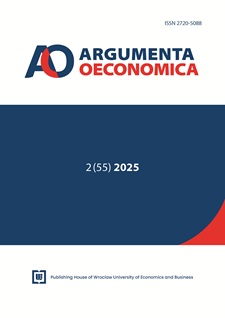The impact of economic crises on youth unemployment in rural areas of the European Union
DOI:
https://doi.org/10.15611/aoe.2025.2.06Keywords:
rural areas, youth unemployment rate, economic crisesAbstract
Aim: The objective of this study was to research the vulnerability of youth unemployment in rural areas of the European Union to the global financial crisis of 2007 and COVID-19 pandemic.
Methodology: The Eurostat data were used to show the differences in unemployment rates of young people in rural areas before and after the financial crisis of 2007 and the COVID-19 pandemic. The results were compared with the data for older people as well as young people living elsewhere using Eurostat database age groups.
Results: The results demonstrate that young people in rural areas are more severely affected by the crises compared to other analysed groups. However, the pace of recovery from high unemployment in this group is higher compared to urban areas. The authors also found that in EU countries where unemployment rates increased significantly after the 2007 financial crisis, young people in rural areas continue to face high unemployment rates above the EU average.
Implications and recommendations: In order to design rural development programmes to support job creation it is of crucial importance to monitor levels of the rural youth labour market. Moreover, active labour policies, such as training and education, should be undertaken with the objective of increasing flexibility of young people in the rural labour market.
Originality/value: The novelty of this research lies in its empirical demonstration that youth unemployment in rural areas is particularly vulnerable. Therefore, it warrants special attention in policy-making.
Downloads
References
Antipova, A. (2021). Analysis of the COVID-19 impacts on employment and unemployment across the multi-dimensional social disadvantaged areas. Social Sciences & Humanities Open, 4(1), 100224. https://doi.org/10.1016/j.ssaho.2021.100224
Beatty, C.,& Fothergill, S. (1999). Labour market detachment in rural England. Countryside Agency.
Bell, D. N. F., & Blanchflower D. G. (2015). Youth unemployment in Greece: Measuring the challenge. IZA J Labor Studies, 4(1). https://doi.org/10.1186/2193-9012-4-1
Blustein, D. L., Duffy, R., Ferreira, J. A., Cohen-Scali, V., Cinamon, R. G., & Allan B. A. (2020). Unemployment in the time of COVID-19: A research agenda. Journal of Vocational Behavior, 119, 103436. https://doi.org/10.1016/j.jvb.2020.103436
Bocchino, A., Gilart, E., Roman, I. C., & Lepiani, I. (2021). Unemployment Syndrome during COVID-19: A Comparison of Three Population Groups. International Journal of Environmental Research and Public Health, 18(4), 7372. https://doi.org/10.3390/ijerph18147372
Cartmel, F., & Furlong, A. (2000). Youth unemployment in rural areas. Joseph Rowntree Foundation.
Cazes, S., Verick, S., & Al Hussami, F. (2013). Why did unemployment respond so differently to the global financial crisis across countries? Insights from Okun’s Law. IZA Journal of Labor Policy, 2(10). https://doi.org/10.1186/2193-9004-2-10
Copus, A., Hall, C., Barnes, A., Dalton, G., Cook, P., Weingarten, P., Baum, S., Stange, H., Lindner, C., Hill, A., Eiden, G., McQuaid, R., Grieg, M., & Johansson, M. (2006). Study on Employment in Rural Areas. Final Deliverable, European Commission Directorate General for Agriculture.
De Beer, P. (2012). Earnings and income inequality in the EU during the crisis. International Labour Review, 151(4), 313-331. https://doi.org/10.1111/j.1564-913X.2012.00151.x
De Hoyos, M., & Green, A. (2011). Recruitment and retention issues in rural labour markets. Journal of Rural Studies, 27(2), 171-180. https://doi.org/10.1016/j.jrurstud.2010.12.003
Eurofound. (2014). Social situation of young people in Europe. Publications Office of the European Union.
Eurostat. (2016). http://ec.europa.eu/eurostat/statistics-explained/index.php/Urban-rural_typology)
Experian. (2005). Retention of skilled workers – phase 2. Lincolnshire Development.
Fraga, V., & Duarte Rocha, M. (2014). Vulnerabilities underlying the impact of the global financial crisis across Europe. Eastern
European Economics, 52(2), 28-48. https://doi.org/10.2753/EEE0012-8775520202
Hadyński, J. (2015). Regionalna konkurencyjność obszarów wiejskich. Wydawnictwo Uniwersytetu Przyrodniczego w Poznaniu.
Hodge, I., Dunn, J., Monk, S., & Fitzgerald, M.(2002). Barriers to participation in residual labour markets. Work, Employment and Society, 16(3), 457-476. https://doi.org/10.1177/095001702762217434
Huang, J., Huayong, Z., Zhurong, H., Rozelle, S., & Giles, J. (2010). The impact of the global financial crisis on off-farm employment and earnings in rural China. World Development, 39(5), 797-807. https://doi.org/10.1016/j.worlddev.2010.09.017
International Labour Organization. (2020). World Employment and Social Outlook Trends 2020. https://www.ilo.org/sites/default/files/wcmsp5/groups/public/@dgreports/@dcomm/@publ/documents/publication/wcms_734455.pdf
Istenic, M. C., & Copus, A. (2009). Rural employment. European development opportunities for rural areas. European Union.
Junankar, PN (Raja). (2015). The impact of the global financial crisis on youth unemployment. The Economic and Labour Relations Review, 26(2), 191-217. https://doi.org/10.1177/1035304615580536
Junankar, PN (Raja). (2011). The global economic crisis: long term unemployment in the OECD. IZA Discussion Paper No. 6057. IZA.
Kraatz, S. (2015). Youth unemployment in Greece: Situation before the government change. European Parliament. Policy Department A: Economy and Scientific Policy, PE 542.220.
Krugman, P. (2008). The return of depression economics and the crisis of 2008. Norton Lincoln.
Krzysztofik, R., Kantor-Pietraga, I., & Spórna, T. (2020). Spatial and functional dimensions of the COVID-19 epidemic in Poland. Eurasian Geography and Economics, 61(4-5), 573-586. https://doi.org/10.1080/15387216.2020.1783337
Lindsay, C., McCracken, M., & McQuaid, R. W. (2003). Unemployment duration and employability in remote rural labour markets. Journal of Rural Studies, 19(2), 187-200. https://doi.org/10.1016/S0743-0167(02)00067-0
Marelli, E., Patuelli, R., & Signorelli, M. (2012). Regional unemployment in the EU before and after the global crisis. Post-Communist Economies, 24(2), 155-175. http://dx.doi.org/10.1080/14631377.2012.675153
Marer, P. (2010). The global economic crises: Impacts on Eastern Europe. Acta Oeconomica, 60(1), 3-33. http://dx.doi.org/10.1556/AOecon.60.2010.1.2
Monk, S., Dunn, J., Fitzgerald, M., & Hodge, I. (1999). Finding work in rural areas: Barriers and bridges. Joseph Rowntree Foundation.
Monk, S., Hodge, I., & Dunn, J. (2000). Supporting rural labour markets. Local Economy, 15(4), 302-311. https://doi.org/10.1080/026909400750068022
Murdoch, J., Lowe, P., Ward, N., & Marsden, T. (2003). The differentiated countryside. Routledge.
Ӧtker-Robe, I., & Podpiera, A. M. (2013). The social impact of financial crises. evidence of the global financial crisis. Policy Research Working Paper 6703, The World Bank, Development Economics, Office of the Senior Vice President and Chief Economist. http://documents.worldbank.org/curated/en/498911468180867209
Peters, D. J. (2020). Community susceptibility and resilience to COVID‐19 across the rural‐urban continuum in the United States. Journal of Rural Health, 36(3), 446-465. https://doi.org/10.1111/jrh.12477
Petterson, S., Westfall, J. M., & Miller, B. F. (2020). Projected deaths of despair from COVID-19. Articles, Abstracts, and Reports, 3054. https://digitalcommons.providence.org/publications/3054/
Pizzoli, E., & Gong, X. (2008). How to best classify rural and urban? Asia and Pacific Commission on Agricultural Statistics, FAO.
Scarpetta, S., Sonnet, A., Livanos, I., Núñez, I., Riddell, W., C., Song, X., & Maselli I.(2012). Challenges facing European labour markets: Is a skill upgrade the appropriate instrument? Intereconomics, 47(1), 4-30. https://doi.org/10.1007/s10272-012-0402-2
Shucksmith, M. (2004). Young people and social exclusion in rural areas. Sociologia Ruralis, 44(1), 43-59. http://dx.doi.org/10.1111/j.1467-9523.2004.00261.x
Shucksmith, M., & Philip, L. (2000). Social exclusion in rural areas: A literature review and conceptual framework. Scottish Executive Central Research Unit.
Smith, A., & Swain, A. (2010). The global economic crisis, Eastern Europe, and the former Soviet Union: Models of development and the contradictions of internationalization. Eurasian Geography and Economics, 51(1), 1-34. https://doi.org/10.2747/1539-7216.51.1.1
Tamesberger, D., & Bacher, J. (2020). COVID-19 crisis: How to avoid a ‘lost generation’. Intereconomics, 55, 232-238. https://doi.org/10.1007/s10272-020-0908-y
Tridico, P. (2013). The impact of the economic crisis on EU labour markets: A comparative perspective. International Labour Review, 152(2), 175-190. https://doi.org/10.1111/j.1564-913X.2013.00176.x
UNECE. (2007). Regional household’s livelihood and well-being statistics on rural development and agriculture household income. United Nations Economic Commission for Europe, FAO, The World Bank, Eurostat, New York and Geneva.
Weinstock, L. R. (2020). COVID-19: How quickly will unemployment recover? Prepared by the congressional research service (CRS). CRS report IN11460. https://crsreports.congress.gov/product/pdf/IN/IN11460
Downloads
Published
License
Copyright (c) 2025 Ewa Kiryluk-Dryjska, Agnieszka Baer-Nawrocka

This work is licensed under a Creative Commons Attribution-ShareAlike 4.0 International License.
Accepted 2025-03-13
Published 2025-09-30








